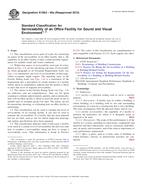Wir benötigen Ihre Einwilligung zur Verwendung der einzelnen Daten, damit Sie unter anderem Informationen zu Ihren Interessen einsehen können. Klicken Sie auf "OK", um Ihre Zustimmung zu erteilen.
ASTM E1692-95a(2012)
Standard Classification for Serviceability of an Office Facility for Change and Churn by Occupants (Includes all amendments And changes 4/4/2018).
Automatische name übersetzung:
Standardklassifikation für Wartungsfreundlichkeit eines Office Facility for Change and Churn von Insassen
NORM herausgegeben am 1.4.2012
Informationen über die Norm:
Bezeichnung normen: ASTM E1692-95a(2012)
Anmerkung: UNGÜLTIG
Ausgabedatum normen: 1.4.2012
SKU: NS-42673
Zahl der Seiten: 11
Gewicht ca.: 33 g (0.07 Pfund)
Land: Amerikanische technische Norm
Kategorie: Technische Normen ASTM
Kategorie - ähnliche Normen:
Die Annotation des Normtextes ASTM E1692-95a(2012) :
Keywords:
air diffusers, relocating, air exhaust (in building), special, building, change and churn by occupants, facility, facility occupants, function, light fixtures, relocating, office, partition walls, in office, performance, rating, rating scale, requirements, serviceability, use, walls (partition) in office, workplace layouts, changes in, ICS Number Code 35.260 (Office machines)
Ergänzende Informationen
| Significance and Use | ||||||||
|
Each Facility Rating Scale in this classification provides a means for estimating the level of serviceability of a building or facility for one topic of serviceability, and for comparing that level against the level of any other building or facility. This classification can be used for comparing how well different buildings or facilities meet a particular requirement for serviceability. It is applicable despite differences such as location, structure, mechanical systems, age, and building shape. This classification can be used to estimate the amount of variance of serviceability from target or from requirement for a single office facility or within a group of office facilities. This classification can be used to estimate the following: (1) the serviceability of an existing facility for uses other than its present use; (2) the serviceability (potential) of a facility that has been planned but not yet built; and (3) the serviceability (potential) of a facility for which a remodelling has been planned. The use of this classification does not result in building evaluation or diagnosis. Building evaluation or diagnosis generally requires special expertise in building engineering or technology and the use of instruments, tools, or measurements. This classification applies only to facilities that are building constructions or parts thereof. (While this classification may be useful in rating the serviceability of facilities that are not building constructions, such facilities are outside the scope of this classification.) This classification is not intended for, and is not suitable for, use for regulatory purposes, nor for fire hazard assessment or fire risk assessment. |
||||||||
| 1. Scope | ||||||||
|
1.1 This classification covers pairs of scales for classifying an aspect of the serviceability of an office facility, that is, the capability of an office facility to meet certain possible requirements to accommodate changes in working method, and frequent relocations of staff, and realignment of workstations. 1.2 Each pair of scales shown in Figs. 1-5, printed side by side on a page, are for classifying one topic of serviceability within that aspect of serviceability. Each paragraph in an Occupant Requirement Scale (see Figs. 1-5) summarizes one level of serviceability on that topic that occupants might require. The matching entry in the Facility Rating Scale (see) is a translation of the requirement into a description of certain features of a facility that, taken in combination, indicate that the facility is likely to meet that level of required serviceability. 1.3 The entries in the Facility Rating Scale (see Figs. 1-5) are indicative and not comprehensive. They are for quick scanning, to estimate approximately, quickly, and economically how well an office facility is likely to meet the needs of one or another type of occupant group over time. The entries are not for measuring, knowing, and evaluating how an office facility is performing. 1.4 This classification can be used to estimate the level of serviceability of an existing facility. It can also be used to estimate the serviceability of a facility that has been planned but not yet built, such as one for which single-line drawings and outline specifications have been prepared. 1.5 This classification indicates what would cause a facility to be rated at a certain level of serviceability, but it does not state how to conduct a serviceability rating or how to assign a serviceability score. That information is found in Practice E1334. The scales in this classification are complementary to and compatible with Practice E1334. Each requires the other.
|
||||||||
| 2. Referenced Documents | ||||||||
|
Ähnliche Normen:
Historisch
1.4.2012
Historisch
1.4.2012
Historisch
1.4.2012
Historisch
1.4.2010
Historisch
1.4.2012
Historisch
1.4.2012
Empfehlungen:
EEviZak – alle Gesetze einschließlich ihrer Evidenz in einer Stelle
Bereitstellung von aktuellen Informationen über legislative Vorschriften in der Sammlung der Gesetze bis zum Jahr 1945.
Aktualisierung 2x pro Monat!
Brauchen Sie mehr Informationen? Sehen Sie sich diese Seite an.



 ASTM E1660-95a(2012)..
ASTM E1660-95a(2012).. ASTM E1661-95a(2012)..
ASTM E1661-95a(2012).. ASTM E1662-95a(2012)..
ASTM E1662-95a(2012).. ASTM E1663-03(2010)..
ASTM E1663-03(2010).. ASTM E1664-95a(2012)..
ASTM E1664-95a(2012).. ASTM E1665-95a(2012)..
ASTM E1665-95a(2012)..
 Cookies
Cookies
